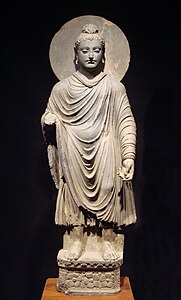
Buddhism in Pakistan took root some 2,300 years ago under the Mauryan king Ashoka who sent missionaries to the Kashmira-Gandhara region of North West Pakistan extending into Afghanistan, following the Third Buddhist council in Pataliputra (modern India).[1][2][3]
Buddhism first reached what is now Pakistan during Ashoka’s reign when he sent a monk from Varanasi called Majjhantika to preach in Kashmir and Gandhara.[4][5][6][7]
The Major Rock Edicts of Ashoka inscribed on rock boulders in Mansehra and Shahbaz Garhi written in the Kharosthi script recording aspects of the emperor's dharma or righteous law represent some of the earliest evidence of deciphered writing in South Asia, dating to middle of the third century BCE.[8] The Indo-Greek king Menander embraced Buddhism as attested in the Milinda Panha, which dates from sometime between 100 BC and 200 AD, following a dialogue with the monk Nāgasena in Sagala, present-day Sialkot.[9]
Mahayana Buddhism, one of the most prominent branches of Buddhism today, is believed to have been originated in the region of Gandhara, although its total number of confirmed Buddhists is a fraction of what it was.[dubious – discuss][10][11][12] In the Gandhara region, Greco-Buddhist art and sculptures flourished.[13]
Buddhism thrived until the 6th century, when the religion began to decline after the invasion by Alchon Huns,[14][15][16] until by the end of the 14th century, Buddhism had largely disappeared following the muslim conquests in the Indian subcontinent.[17][18][19]
In 2012, the National Database and Registration Authority (NADRA) of Pakistan indicated that the contemporary Buddhist population of Pakistan was minuscule, with 1,492 adult holders of national identity cards (CNICs). The total population of Buddhists is therefore unlikely to be more than a few thousand.[20] In 2017, the number of Buddhist voters was stated to be 1,884, and they were mostly concentrated in Sindh and Punjab.[21]
The only functional Buddhist temple in Pakistan is in the Diplomatic Enclave at Islamabad, used by Buddhist diplomats from countries like Sri Lanka.[22] Recently in 2023, Fo Guang Shan, a large international Buddhist organization has been invited by the Pakistani government to reconnect the local indigenous Buddhist population to the faith by organizing event, reciting prayers and singing hymns to praise the Buddha in the local tongue. [23]
- ^ Rengel, Marian (15 December 2003). Pakistan: A Primary Source Cultural Guide. The Rosen Publishing Group, Inc. pp. 59–62. ISBN 978-0-8239-4001-1. Archived from the original on 15 January 2023. Retrieved 4 August 2022.
- ^ "Buddhism In Pakistan". pakteahouse.net. Archived from the original on 20 January 2015. Retrieved 20 January 2015.
- ^ Buswell, Robert; Lopez, Donald (2014). The Princeton Dictionary of Buddhism. Princeton University Press. pp. 424–425. ISBN 9780691157863. Archived from the original on 15 January 2023. Retrieved 21 November 2021.
- ^ Buswell Jr, Robert (2014). "Madhyāntika". Princeton Dictionary of Buddhism. Princeton University Press. p. 490. ISBN 978-0-691-15786-3.
- ^ Bansi Lal Malla (1990). Sculptures of Kashmir, 600-1200 A.D. Agam Kala Prakashan. p. 7. ISBN 978-0-8364-2521-5.
- ^ Kumāra, Braja Bihārī (2007). India and Central Asia: Classical to Contemporary Periods. Concept Publishing Company. p. 66. ISBN 978-81-8069-457-8.
- ^ Hirakawa, Akira (1993). A History of Indian Buddhism: From Śākyamuni to Early Mahāyāna. Motilal Banarsidass Publ. p. 87. ISBN 978-81-208-0955-0.
- ^ Department of Archaeology and Museums (30 January 2004). "UNESCO world heritage Centre - Mansehra Rock Edicts". Whc.unesco.org. Retrieved 30 March 2011.
- ^ Pesala (Bhikkhu.) (1991). The Debate of King Milinda: An Abridgement of the Milinda Pañha. Motilal Banarsidass Publ. p. 19. ISBN 978-81-208-0893-5.
- ^ "Remembering Pakistan's Buddhist past | The Express Tribune". tribune.com.pk. 11 June 2022. Retrieved 16 January 2023.
- ^ Karashima, 2013.
- ^ Walser, Joseph, Nagarjuna in Context: Mahayana Buddhism and Early Indian Culture, Columbia University Press, 2005, p. 25.
- ^ "Long Read: A Pakistani homeland for Buddhism: Buddhist art, Muslim nationalism and global public history". South Asia@LSE. 22 July 2019. Retrieved 16 January 2023.
- ^ Grousset, Rene (1970). The Empire of the Steppes. Rutgers University Press. pp. 69–71. ISBN 0-8135-1304-9.
- ^ Wendy Doniger (1999). Merriam-Webster's Encyclopedia of World Religions. Merriam-Webster. pp. 155–157. ISBN 978-0-87779-044-0.
- ^ Ann Heirman; Stephan Peter Bumbacher (11 May 2007). The Spread of Buddhism. Leiden: BRILL. p. 60. ISBN 978-90-474-2006-4.
- ^ MacLean, Derryl L. (1989). Religion and Society in Arab Sind. BRILL. pp. 12–14, 77–78. ISBN 978-90-040-8551-0.
- ^ Cite error: The named reference
:15was invoked but never defined (see the help page). - ^ Naik, C. D. (2010). Buddhism and Dalits: Social Philosophy and Traditions. Gyan Publishing House. p. 39. ISBN 978-81-7835-792-8.
Buddhism survived in Gilgit and Baltistan until 13-14th Century, perhaps slightly longer in the nearby Swat Valley.
- ^ "Over 35,000 Buddhists, Baha'is call Pakistan home". Tribune. Archived from the original on 2 November 2012.
- ^ "Pakistan elections: Non-Muslim voters up by 30%, Hindus biggest minority". 28 May 2018. Archived from the original on 18 September 2020. Retrieved 9 August 2018.
- ^ "Vesak Festival in Islamabad". mfa.gov.lk. Archived from the original on 13 November 2016. Retrieved 5 May 2018.
- ^ 人間福報. "復興巴基斯坦佛教 佛光僧侶宣法 | 覺世.宗教". 人間福報 (in Chinese). Retrieved 2 June 2023.